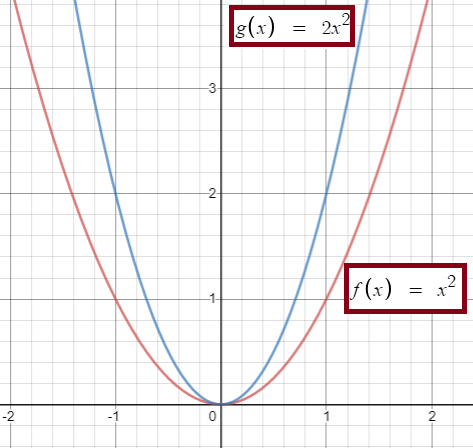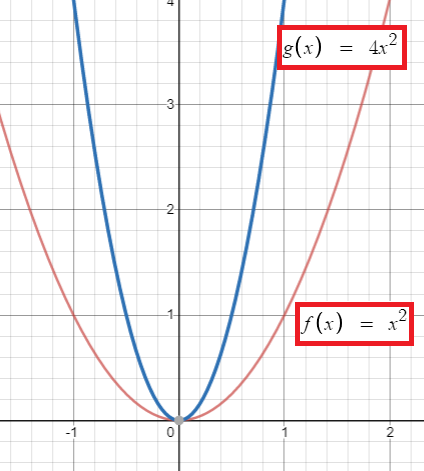STRETCH A GRAPH VERTICAL OR HORIZONTAL EXAMPLES
Subscribe to our ▶️ YouTube channel 🔴 for the latest videos, updates, and tips.
Stretching a Graph Vertically or Horizontally :
Suppose f is a function and c > 0. Define functions g and h by g(x) = c f(x) and h(x) = f(cx).
Then
- The graph of g is obtained by vertically stretching the graph of f by a factor of c.
- In vertical stretching, the domain will be same but in order to find the range, we have to multiply range of f by the constant "c".
- The graph of h is obtained by horizontally stretching the graph of f by a factor of 1/c.
- In horizontal stretching, the range will be same but in order to find the domain, we have to multiply the domain of f by the constant "1/c".
The procedure for stretching the graph of a function vertically or horizontally is illustrated by the following examples :
Question 1 :
Define a function g by g(x) = 2f(x),
where f is the function defined by f(x) = x2, with the domain of f the interval [−1, 1].
(a) Find the domain of g.
(b) Find the range of g.
(c) Sketch the graph of g.
Solution :
(a) Here the function g(x) is defined by the function f(x), so the domain of both functions will be same. Hence the domain of g in the interval [-1, 1].
(b) By multiplying each range of f(x) by 2, we get the range of the function g(x).
Range of f(x) by applying domain, we get
f(x) = x2
If x = -1, then y = 1
If x = 0, then y = 0
If x = 1, then y = 1
Range of f(x) is [0, 1]. By multiplying 2, we get the range of g(x). That is [0, 2].
(c) Since 2 is the integer multiplied with the function, we have to stretch the graph vertically.

Question 2 :
Define a function h by
h(x) = f(2x),
where f is the function defined by f(x) = x2, with the domain of f the interval [−1, 1].
(a) Find the domain of h.
(b) Find the range of h.
Solution :
(a) The formula defining h shows that h(x) is defined precisely when f(2x) is defined, which means that 2x must be in the interval [−1, 1].
Here the constant c is 1/2, which means that x must be in the interval [−1/2 , 1/2 ]. Thus the domain of h is the interval [−1/2 , 1/2].
(b) Because h(x) equals f(2x), we see that the values taken on by h are the same as the values taken on by f . Thus the range of h equals the range of f , which is the interval [0, 1].

Subscribe to our ▶️ YouTube channel 🔴 for the latest videos, updates, and tips.
Kindly mail your feedback to v4formath@gmail.com
We always appreciate your feedback.
©All rights reserved. onlinemath4all.com
Recent Articles
-
Factorial Problems and Solutions
Dec 02, 25 09:27 AM
Factorial Problems and Solutions -
10 Hard SAT Math Questions (Part - 36)
Nov 28, 25 09:55 AM
10 Hard SAT Math Questions (Part - 36) -
Digital SAT Math Problems and Solutions (Part - 7)
Nov 26, 25 09:03 AM
Digital SAT Math Problems and Solutions (Part - 7)
